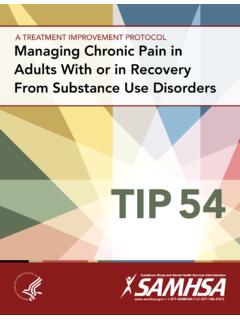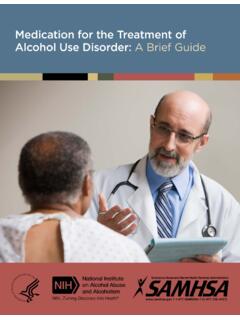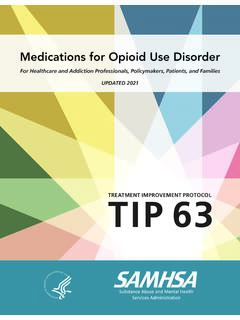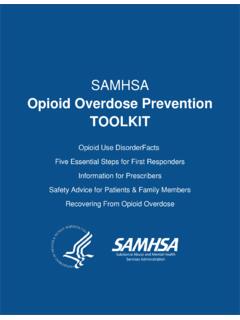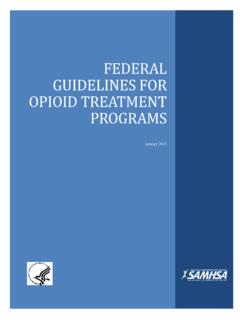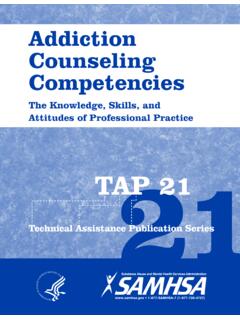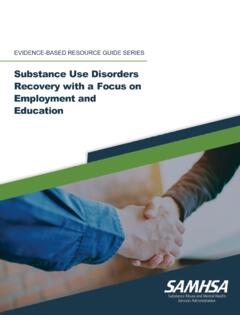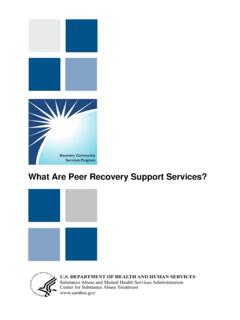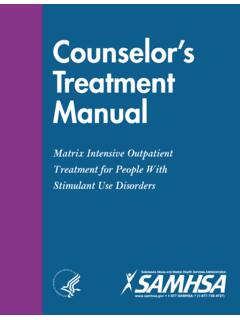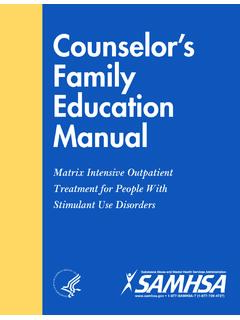Transcription of Telehealth for the Treatment of Serious Mental Illness and ...
1 EVIDENCE-BASED RESOURCE GUIDE SERIEST elehealth for the Treatment of Serious Mental Illness and Substance Use DisordersITelehealth for the Treatment of Serious Mental Illness and Substance Use DisordersAcknowledgmentsThis report was prepared for the Substance Abuse and Mental Health Services Administration (SAMHSA) under contract number HHSS283201700001/ 75S20319F42002 with SAMHSA, Department of Health and Human Services (HHS). Donelle Johnson served as contracting officer views, opinions, and content of this publication are those of the authors and do not necessarily reflect the views, opinions, or policies of SAMHSA.
2 Nothing in this document constitutes a direct or indirect endorsement by SAMHSA of any non-federal entity s products, services, or policies, and any reference to non-federal entity s products, services, or policies should not be construed as Domain NoticeAll material appearing in this publication is in the public domain and may be reproduced or copied without permission from SAMHSA. Citation of the source is appreciated. However, this publication may not be reproduced or distributed for a fee without the specific, written authorization of the Office of Communications, AccessThis publication may be downloaded from Recommended CitationSubstance Abuse and Mental Health Services Administration (SAMHSA).
3 Telehealth for the Treatment of Serious Mental Illness and Substance Use Disorders. SAMHSA Publication No. PEP21-06-02-001 Rockville, MD: National Mental Health and Substance Use Policy Laboratory. Substance Abuse and Mental Health Services Administration, OfficeNational Mental Health and Substance Use Policy Laboratory, Substance Abuse and Mental Health Services Administration, 5600 Fishers Lane, Rockville, MD 20857, Publication No. NoticeSAMHSA complies with applicable federal civil rights laws and does not discriminate on the basis of race, color, national origin, age, disability, or cumple con las leyes federales de derechos civiles aplicables y no discrimina por motivos de raza, color, nacionalidad, edad, discapacidad o No.
4 PEP21-06-02-001 Released 2021 Telehealth for the Treatment of Serious Mental Illness and Substance Use DisordersAcknowledgments Telehealth for the Treatment of Serious Mental Illness and Substance Use Disorders Evidence-Based Resource Guide Series OverviewIIFOREWORDE vidence-Based Resource Guide Series OverviewThe Substance Abuse and Mental Health Services Administration (SAMHSA), and specifically, its National Mental Health and Substance Use Policy Laboratory (Policy Lab), is pleased to fulfill the charge of the 21st Century Cures Act to disseminate information on evidence-based practices and service delivery models to prevent substance misuse and help people with substance use disorders (SUDs), Serious Mental Illness (SMI), and Serious emotional disturbances (SEDs) get the Treatment and support they and recovery for SUD, SMI, and SED can vary based on several factors, including geography, socioeconomics, culture, gender, race, ethnicity, and age.
5 This can complicate evaluating the effectiveness of services, treatments, and supports. Despite these variations, however, there is substantial evidence to inform the types of resources that can help reduce substance use, lessen symptoms of Mental Illness , and improve quality of life. The Evidence-Based Resource Guide Series is a comprehensive set of modules with resources to improve health outcomes for people at risk for, experiencing, or recovering from SMI and/or SUD. It is designed for practitioners, administrators, community leaders, and others considering an intervention for their organization or priority topic for SAMHSA is increasing access to Treatment for SMI and SUD using Telehealth modalities.
6 This guide reviews literature and research findings related to this issue, examines emerging and best practices, discusses gaps in knowledge, and identifies challenges and strategies for implementation. While this guide is focused on the needs of people experiencing SMI and SUD, readers can broadly apply its resources and lessons from the field for the Treatment of any Mental Illness . Expert panels of federal, state, and non-governmental participants provided input for each guide in this series. The panels included accomplished scientists, researchers, service providers, community administrators, federal and state policy makers, and people with lived experience.
7 Members provided input based on their knowledge of healthcare systems, implementation strategies, evidence-based practices, provision of services, and policies that foster shows that implementing evidence-based practices requires a comprehensive, multi-pronged approach. This guide is one piece of an overall approach to implement and sustain change. Readers are encouraged to visit the SAMHSA website for additional tools and technical assistance for the Treatment of Serious Mental Illness and Substance Use Disorders Evidence-Based Resource Guide Series OverviewIIIC ontent of the GuideThis guide contains a foreword and five chapters.
8 The chapters stand alone and do not need to be read in order. Each chapter is designed to be brief and accessible to healthcare providers, healthcare system administrators, community members, policy makers, and others working to meet the needs of people at risk for, experiencing, or recovering from SMI and/or SUD. The goal of this guide is to review the literature on the effectiveness of Telehealth modalities for the Treatment of SMI and SUD, distill the research into recommendations for practice, and provide examples of how practitioners use these practices in their programs. FWEvidence-Based Resource Guide Series OverviewIntroduction to the BriefOverview of the current landscape of Telehealth , including its need, benefits, and challenges for the Treatment of SMI and SUD among adults.
9 2 What Research Tells UsCurrent evidence on effectiveness of integrating Telehealth modalities for the Treatment of SMI and SUD among adults across a continuum of services, including screening and assessment, Treatment , medication management, case management, recovery support, and crisis services. 3 Guidance for Implementing Evidence-based PracticesPractical information to consider at the individual client and provider, provider-client, organizational, and regulatory levels when selecting and implementing Telehealth of Telehealth Implementation in Treatment ProgramsExamples of programs that have implemented Telehealth modalities for the Treatment of SMI and SUD among adults.
10 5 Resources for Evaluation and quality ImprovementGuidance and resources for evaluating Telehealth -delivered practices, monitoring outcomes, and improving OF THE GUIDESMI and SUD impact millions of Americans. Barriers to accessing care include access to appropriate services and providers, stigma associated with SMI or SUD, and competing priorities ( , employment and caregiving responsibilities). Telehealth is the use of two-way, interactive technology to provide health care and facilitate client-provider interactions. Telehealth modalities for SMI or SUD may be synchronous (live or real time) or asynchronous (delayed communication between clients and providers).
